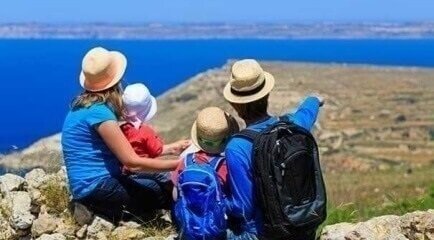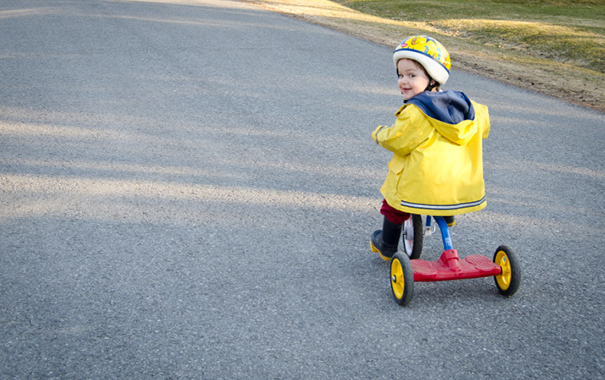
Staying Safe While Enjoying the Great Outdoors
Key Takeaways
As toddlers grow into eager explorers, it’s the perfect time to teach outdoor safety habits that build confidence and independence.
Use broad-spectrum sunscreen (SPF 15–30+), reapplying every 2 hours—and let your child practice applying it with your supervision.
Pack essentials: water, snacks, a wide-brimmed hat, and an emergency shelter, like a garbage bag poncho, can all help keep your child safe and comfortable.
Prepare for the unexpected: teach your child to stay put and “hug a tree” if lost, and practice using a whistle and following a family signal.
Dress smart: use insect repellent, wear long pants when needed, and check for ticks after outings.
Encourage safe leadership by letting your child take turns leading hikes while staying connected with the group.
After age 3, your child wants to spend at least part of the time on his own two feet. As he gets closer to 4, he'll want to be even more mobile as he develops into an explorer on family outings. Even as you rejoice in becoming equipment-free, you'll want to acquire as much knowledge as possible to protect your little adventurer.
Teach Your Child
So whether you're setting off on a camping or fishing trip a long way from home or going for a hike in a local park, you and your kids should know what to do if they or you get lost or separated from each other. You should also know something about conserving energy and protecting skin. The things children learn on these outings should prepare them for a life of outdoor fun and adventure.
9 Tips to Keep Toddlers Safe Outdoors
The following nine easy precautions will help keep your outdoor excursions safe.
Sunscreen Rules. Even on cloudy days the sun's rays can burn. Winter excursions are just as bad as summer outings for the face and other exposed skin. Always smooth on a layer of broad-spectrum sunscreen with an SPF of 15 to 30 or higher before you start out and reapply after two hours. Have kids over 3 try to do it themselves to start learning the habit, but make sure an adult checks for full coverage.
Hats On. Hats are much more than decoration. In winter we lose a lot of body heat from an exposed head; in summer we gain heat this way. This rule applies even more so to kids because of their relatively large head size compared to their body size. Scalp sunburn is painful and dangerous, and being too cold (hypothermia) or too warm (hyperthermia) is easier to avoid when heads are covered.
Water Wise. Bring lots of water, and have your kids drink lots of it. You'll avoid the fatigue and dehydration that drinking too little water brings. Slow-moving, irritable kids are often thirsty. As soon as they are 3, they should carry a quart of water themselves in a backpack and take drinks often.
Snack Facts. Kids need refueling at least every two hours. Even if you plan to be out only a short time, pack food for unexpected delays. It's a good habit to develop.
Bagging It. What's black, plastic, and has a hole cut in the bottom? A garbage bag shelter. Don't leave home without putting one into your child's backpack. This humble item will protect her from water and cold if she gets lost and has to remain outside. Show her how the garbage bag makes a magic cape to use only if she is wet and cold or lost. This is not for make-believe; this is your child's emergency shelter.
Here's the four-step procedure to teach your preschooler:
Step 1: After removing your hat, put the open end of the bag over your head like you put on a shirt or sweater.
Step 2: Find the hole that was made in the bottom and poke your head through.
Step 3: Put your hat back on.
Step 4: Huddle underneath, tucking the bag around you.
Blow That Whistle. Put a whistle on a long cord around your child's neck, and tuck it inside his clothes so it won't get caught on anything. Teach him to blow it only if he is lost. Again, emphasize to your child (without scaring him) that this isn't a game. Develop a signal (one short whistle, one long one, for example) to call everyone together at a designated meeting area. Don't count on kids under 5 to remember that place, but go through the routine all the same; eventually they will remember, and in the meantime it sets up good habits.
Dress for Success. Wear long pants and high boots if critter bites, underbrush scratches, and poison ivy are a possibility. Use insect repellent, and check clothing for ticks at the end of an outing in the woods or fields.
Leader of the Pack. Make your child the leader of the hike. She'll be proud, and you'll be able to keep your eye on her. Teach your leader to keep checking back on her followers to be sure that everyone stays together.
Hug a Tree. This isn't philosophy or ecology — it's safety. Teach kids to literally hug a tree if they are lost. Tell them to find the loneliest tree around and then go hug it. And keep on hugging it. Kids are easier to find when they stay put.
Related Articles
Read more about Toddler
Related Articles
Join a World of Support
through Pregnancy and Parenthood.
![toy]()
TRACK WITH TOOLS
![baby]()
LEARN WITH EXPERTS
![Gift]()
GET REWARDED

Where You Already Belong



